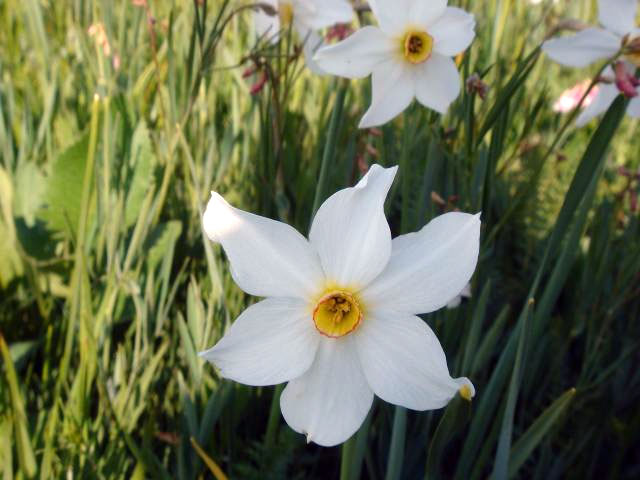Protected Area
Identity Card
- Sirente Velino Regional Park:
- Land Surface Area: 54'361.00 ha
- Protected flora: 2 species (Italian text)
- Protected wildlife: 63 species (Italian text)
- Habitats: 22 types (Italian text)
- Regions: Abruzzo
- Provinces: L'Aquila
- Municipalities: Acciano, Aielli, Castel di Ieri, Castelvecchio Subequo, Celano, Cerchio, Collarmele, Fagnano Alto, Fontecchio, Gagliano Aterno, Goriano Sicoli, Magliano de' Marsi, Massa d'Albe, Molina Aterno, Ocre, Ovindoli, Pescina, Rocca di Cambio, Rocca di Mezzo, San Demetrio Nè Vestini, Secinaro, Tione degli Abruzzi
- Establishment Measures: LR 54 13/07/1989 - LR 38 21/06/1996 - LR 23 del 07/03/2000
- PA Official List: EUAP0173
- Park Authority: Parco Naturale Regionale Sirente Velino
- Further managed Protected Areas:
- SIC Colle del Rascito
- SIC Monte Sirente e Monte Velino
- SIC Serra e Gole di Celano - Val d'Arano
- ZPS Sirente Velino
![]() The Statute (PDF - 63Kb)
The Statute (PDF - 63Kb)
Nature
Sirente-Velino Regional Park is characterized by various environments, from the mountain to the mid-mountain environment, from hilly to river landscapes, from 2,300 to 600 meters of altitude.
Each environment houses a particular kind of fauna and vegetation. According to recent censuses, at the moment in the Park there are 1,926 flower species; 216 vertebrate species; 149 birds; 43 mammals; 13 reptiles; 11 amphibians.
From the morphological point of view, the Park territory is distributed in three broad sectors, each characterized by particular aspects.
Fauna
The Park area, covering about 50,250 ha, is considerably diversified for the orographic features of the territory and typology of environments housing a great variety of vegetable and animal species.
The big difference in height, the considerable differences between slopes with a different exposure, the morphology marked by canyons, plateaus, deep gorges, cliffs, and screes form a great variety of environments characterized by a wide range of vegetal formations and wildlife species representing a cross section of the ecosystem biodiversity of the Central Apennines.
Within this variety of habitats and landscapes it is also possible to identify wild and inaccessible places, with large forests and rock formations still populated by Marsican bear, Apennine wolves and golden eagles, which flank areas where the historical presence of man is witnessed by ancient settlments and well-preserved historic centers.
Vegetation and Flora
Sirente Velino Park is a wonderful example of floristic biodiversity: according to censuses, the Park houses 1,570 species, gathered in 516 genera and 102 families.
Out of them, 116 floristic essences represent important naturalistic features (endemic species, glacial relicts, species with a separated or fragmentary distribution, and rare species) and include particularly rare species like Astragalus aquilanus - exclusively living in some mountain areas of Abruzzi - and Adonis distorta - exclusively living in some areas of the Central Apennines. There are also important species of orchids, narcissi, as well as rare peonies and Viola eugeniae.
All this thanks to the great variety of environments that characterize the territory, to the variety of exposures, to the moving morphology of the territory, to the high altitudinal gradient (from 400-600 mt. along the Aterno Valley, to the maximum altitude of 2,486 mt).
Geological Origins
As far as geology is concerned, the area of Sirente Velino Park is characterized by Mesozoic formations, with Cretaceous organogenic limestone forming most of the mountains; however, there is also limestone dating back to the Jurassic period.
The Tertiary formations are well evident, with the marly limestone of the Lower Miocene both on the south-western slope and in the north of Sirente chain, with mountain layer debris; they are also evident near Altopiani delle Rocche with the molassic series of the Middle-Upper Miocene.
However, due to their diversity of origin and composition, the more recent lands of the Quaternary play a primary role in determining the morphological structure of the entire area.
Karstic Phenomena
Karstic phenomena are very widespread in the area of Sirente Velino Park. As a matter of fact, it is frequent to meet pot holes, caves, and dolines, all evidences of how this phenomenon is still particularly active.
Among the various karst manifestations, the sinkhole of Terranera, the so-called Pozzo Caldaio, is of considerable interest in the closed basin of Rocca di Cambio, where the waters of the plain disappear, only to reappear, further east, in the resurgence of the Caves of Stiffe, rich in calcareous concretions of particular scenografic effect and protected by a landscape constraint. From the cave, which could be reached from the hamlet of Stiffe, in the Municipality of S. Demetrio Nè Vestini, the water comes out in a wild environment with remarkable jumps and rocky crags, covered with herbaceous and shrub vegetaion of remarkable visual and sound suggestive effect. The waters, in turn, enrich the flow of the Aterno river that crosses the Aterno Valley and the Subequana Valley.
Mountain Groups
Sirente-Velino group forms a sort of belt used by the wildlife to go from one side to the other of the Apennines. It has a strategic topographical importance, since it represents a necessary connection between the mountains of Reatino, northern Simbruini, the area of Abruzzo, Lazio and Molise National Park (in the south-east) and Gran Sasso e Monti della Laga National Park in the north.
The two massifs denote differences and similarities both in the vegetation that covers their slopes and in reference to their origins. Despite being separated from the Altopiano delle Rocche, the two groups could be considered unitarily both in reference to the same geological and tectonic origin.












